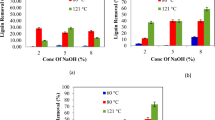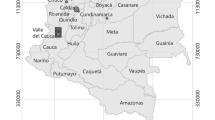Abstract
The torrefaction assays were carried out at temperatures of 240, 260, and 280 °C for 30 and 60 min to investigate the chlorine (Cl) behavior in Eucalyptus sp. from the region of Paraiba Valley, Brazil. The solid product obtained from the reactions — torrefied wood — was analyzed for mass loss, elemental analysis, calorific value, scanning electron microscopy, and chlorine content. The results showed that the mass loss ranged from 11.5 to 16.7% at the lowest temperatures tested, reaching 37.2% at 280 °C for 60 min. The samples torrefied at 260 and 280 °C for 60 min showed characteristics similar to lignite and peat, which have higher heating values. However, torrefied reactions of 30 min had better energy yields (97.6%). It is noteworthy that during torrefaction at 240 °C and 260 °C for 30 min, the chlorine reduction was 88 and 95% respectively, in relation to raw wood, resulting in concentrations of 30 and 13 mg kg−1 of chlorine in the torrefied samples, meeting the specification of the ENplus standard (< 200 mg kg−1). Thus, torrefaction is a pretreatment process for Eucalyptus sp. from Paraiba Valley, state of São Paulo (Brazil), to produce biofuel with low chlorine content, enabling its commercialization in the European market.






Similar content being viewed by others
References
Basu P (2010) Biomass gasification and pyrolysis: Practical design and theory. Academic Press, London
Bach Q, Skreiberg Y (2016) Upgrading biomass fuels via wet torrefaction: a review and comparison with dry torrefaction. Renew Sustain Energy Rev 54:665–677. https://doi.org/10.1016/j.rser.2015.10.014
Pimchuai A, Dutta A, Basu P (2010) Torrefaction of agriculture residue to enhance combustible properties. Energy Fuels 24:4638–4645. https://doi.org/10.1021/ef901168f
IBA (2020) Annual Report. https://twosides.org.br/wp-content/uploads/sites/15/2020/10/relatorio-iba-2020.pdf. Accessed 17 September 2021
Couto L, Dube F (2001) The status and practice of forestry in Brazil at the beginning of the 21st century: a review. For Chron 77:817–830. https://doi.org/10.5558/tfc77817-5
Eufrade HJ, Melo RX, Sartori MMP, Guerra SPS, Ballarin AW (2016) Sustainable use of eucalypt biomass grown on short rotation coppice for bioenergy. Biomass Bioener 90:15–21. https://doi.org/10.1016/j.biombioe.2016.03.037
EN (2011) European Normalization. EN14961–2: Solid biofuels – fuel specifications and classes - part 2: wood pellets for non-industrial use. European Standards. https://standards.iteh.ai/catalog/standards/cen/05d820de-8dca-4180-b45b-8e4ca0973f6c/en-14961-2-2011
Deng L, Zhang T, Che D (2013) Effect of water washing on fuel properties, pyrolysis and combustion characteristics, and ash fusibility of biomass. Fuel Process Technol 106:712–720. https://doi.org/10.1016/j.fuproc.2012.10.006
Baxter LL, Miles TR, Miles TR Jr, Jenkins BM, Milne TA, Dayton D, Bryers RW, Oden LL (1998) The behavior of inorganic material in biomass-fired power boilers: field and laboratory experiences. Fuel Process Technol 54:47–78. https://doi.org/10.1016/S0378-3820(97)00060-X
Lee JS, Ghiasi B, Lau AK, Sokhansanj S (2021) Chlorine and ash removal from salt-laden woody biomass by washing and pressing. Biomass Bioenergy 155:106272. https://doi.org/10.1016/j.biombioe.2021.106272
Liu X, Bi XT (2011) Removal of inorganic constituents from pine barks and switchgrass. Fuel Process Technol 92:116598. https://doi.org/10.1016/j.fuproc.2011.01.016
Bridgeman TG, Jones JM, Williams A, Waldron DJ (2010) An investigation of the grindability of two torrefied energy crops. Fuel 89:3911–3918. https://doi.org/10.1016/j.fuel.2010.06.043
Keipi T, Tovanen H, Kokko L, Raiko R (2014) The effect of torrefaction on the chlorine content and heating value of eight woody biomass samples. Biomass Bioener 66:323–239. https://doi.org/10.1016/j.biombioe.2014.02.015
Olugbade TO, Ojo OT (2020) Biomass torrefaction for the production of high-grade solid biofuels: a review. Bioenergy Res 13:999–1015. https://doi.org/10.1007/s12155-020-10138-3
Pereira BLC (2014) Properties of pellets: biomass, additives and heat treatment. Thesis. Federal University of Viçosa. http://www.locus.ufv.br/handle/123456789/6843. Accessed 10 Mar 2021
Bjorkman E, Stromberg B (1997) Release of chlorine from biomass at pyrolysis and gasification conditions. Energy Fuels 11:1026–1032. https://doi.org/10.1021/ef970031o
Escobar JF (2016) Sustainable wood production for energy in Brazil: the case of wood pellets. Thesis, University of São Paulo. https://www.teses.usp.br/teses/disponiveis/106/106131/tde-23032017-171758/pt-br.php. Accessed 10 March 2021
Byrne RH, Mackenzie FT, Duxbury AC (2020) Seawater. Encyclopedia Britannica. https://www.britannica.com/science/seawater. Accessed 11 Apr 2021
Jensen PA, Frandsen FJ, Dam-Johansen K, Sander B (2000) Experimental investigation of the transformation and release to gas phase of potassium and chlorine during straw pyrolysis. Energy Fuels 14:1280–1285. https://doi.org/10.1021/ef000104v
Lu P, Huang Q, Bourtsalas ACT, Themelis NJ, Chi Y, Yan J (2019) Review on fate of chlorine during thermal processing of solid wastes. J Environ Sci 78:13–28. https://doi.org/10.1016/j.jes.2018.09.003
He J, Xiong W, Zhang W, Li W, Long K (2016) Study on the high-temperature corrosion behavior of superheater steels of biomass-fired boiler in molten alkali salts’ mixtures. Adv Mech Eng 8:1–9. https://doi.org/10.1177/2F1687814016678163
Everaert K, Baeyens J (2002) The formation and emission of dioxins in large scale thermal processes. Chemosphere 46:439–448. https://doi.org/10.1016/S0045-6535(01)00143-6
Cincinelli A, Pieri F, Zhang Y, Seed M, Jones KC (2012) Compound specific isotope analysis (CSIA) for chlorine and bromine: A review of techniques and applications to elucidate environmental sources and processes. Environ Pollut 169:112–127. https://doi.org/10.1016/j.envpol.2012.05.006
Kaminsky W (1995) Chemical recycling of mixed plastics of pyrolysis. Adv Polym Technol 4:337–344. https://doi.org/10.1002/adv.1995.060140407
Chen D, Gao A, Cen K, Zhang J, Cao X, Ma Z (2018) Investigation of biomass torrefaction based on three major components: hemicellulose, cellulose, and lignin. Energy Convers Manage 169:228–237. https://doi.org/10.1016/j.enconman.2018.05.063
Medic D, Darr M, Shah A, Potter B, Zimmerman J (2011) Effects of torrefaction process parameters on biomass feedstock upgrading. Fuel 91:147–154. https://doi.org/10.1016/j.fuel.2011.07.019
Wang GJ, Luo YH, Deng J, Kuang JH, Zhang YL (2011) Pretreatment of biomass by torrefaction. Chin Sci Bull 56:1442–1448. https://doi.org/10.1007/s11434-010-4143-y
Sarker TR, Nanda S, Dalai AK, Meda V (2021) A review of torrefaction technology for upgrading lignocellulosic biomass to solid biofuels. Bioenergy Res 14:645–669. https://doi.org/10.1007/s12155-020-10236-2
ASTM (2020) American Society for Testing Materials. ASTM E1756: Standard test method for determination of total solids in biomass. ASTM International, West Conshohocken. https://www.astm.org/e1756-08r20.html
ASTM (2017) American Society for Testing Materials. ASTM D 5057. Standard test method for screening apparent specific gravity and bulk density of waste. ASTM International, West Conshohocken. https://www.astm.org/d5057-17.html
ASTM (2016) American Society of Testing Materials. ASTM D5373. Standard test method for determination of carbon, hydrogen and nitrogen in analysis samples of coal and carbon in analysis samples of coal and coke. ASTM International, West Conshohocken. https://www.astm.org/d5373-16.html
ASTM (2019) American Society of Testing Materials. ASTM D5865. Standard test method for gross calorific value of coal and coke. ASTM International, West Conshohocken. https://www.astm.org/d5865_d5865m-19.html
ISO (2016) International Organization for Standardization. EN ISO 16994: determination of total content of sulfur and chlorine in solid biofuels. ISO, Geneva. https://www.iso.org/standard/70097.html
Zhang S, Min G, Wang J, Zhu S, Zhang H, Liu X (2020) Release characteristics of potassium and chlorine for torrefied wheat straw during a combined pyrolysis-combustion system. Bioresour Technol 312:123591. https://doi.org/10.1016/j.biortech.2020.123591
Levine DM, Berenson ML, Krehbiel TC, Stephan DF (2011) Statistics for managers using MS EXCEL, 6 th Edition - Pearson, USA
Zaiontz C (2022) Real statistics using EXCEL. https://www.real-statistics.com/multiple-regression/unbalanced-factorial-anova/. Accessed 11 February 2022
Zaiontz C (2022) Real statistics using EXCEL. https://www.real-statistics.com/multiple-regression/anova-using-regression/. Accessed 11 February 2022
Zaiontz C (2022) Real statistics using EXCEL. https://www.real-statistics.com/one-way-analysis-of-variance-anova/unplanned-comparisons/tukey-kramer-test/. Accessed 11 February 2022
Chen WH, Lin BJ, Lin YY, Chu YS, Ubando AT, Show PL, Ong HC, Chang JS, Ho SH, Culaba HB, Petrissans A, Petrissans M (2021) Progress in biomass torrefaction: Principles, applications and challenges. Prog Energy Combust Sci 82:100887. https://doi.org/10.1016/j.pecs.2020.100887
Nhuchhen DF, Basu P, Acharya B (2014) A comprehensive review on biomass torrefaction. International J Renew Energy Biofuels. https://doi.org/10.5171/2014.506376
Torres SS, Jomaa W, Marc F, Puiggali JR (2010) Causes of color changes in wood during drying. For Stud China 12:167–175. https://doi.org/10.1007/s11632-010-0404-8
Huang Z, Jiang S, Guo J, Wang X, Tan M, Xiong R, Wang Z, Wu Z, Li H (2020) Oxidative torrefaction of Phragnites australis: Gas-pressurized effects and correlation analysis based on color value. Energy Fuels 34:11073–11082. https://doi.org/10.1021/acs.energyfuels.0c01974
Chen WH, Peng J, Bi XT (2015) A state-of-the-art review os biomass torrefaction, densification and applications. Renew Sustain Energy Rev 44:847–866. https://doi.org/10.1016/j.rser.2014.12.039
Silva CMS, Vital BR, Carneiro ACO, Costa EVS, Magalhaes MA, Trugilho PF (2017) Structural and compositional changes in eucalyptus wood chips subjected to dry torrefaction. Industrial Crops Products 109:598–602. https://doi.org/10.1016/j.indcrop.2017.09.010
Chen Q, Zhou JS, Liu BJ, Mei QF, Luo ZY (2011) Influence of torrefaction pretreatment on biomass gasification technology. Chinese Sci Bull 56:1449–1456. https://doi.org/10.1007/s11434-010-4292-z
Singh S, Chakraborty JP, Mondal MK (2019) Optimization of process parameters for torrefaction of Acacia nilotica using response surface methodology and characteristics of torrefied biomass as upgraded fuel. Energy 186:115865. https://doi.org/10.1016/j.energy.2019.115865
Abreu RN, Lima JT, Takarada LM, Trugilho PF (2021) Effect of thermal treatment on fiber morphology in wood pyrolysis. Wood Sci Technol 55:95–108. https://doi.org/10.1007/s00226-020-01238-6
Wang P, Howard BH (2018) Impact of thermal pretreatment temperatures on woody biomass chemical composition, physical properties and microstructure. Energies 11:25. https://doi.org/10.3390/en11010025
Romao EL, Conte RA (2021) Energy gains of Eucalyptus by torrefaction process. Maderas Ciencia Tecnología 23:1–6. https://doi.org/10.4067/s0718-221x2021000100403
Saidur R, Abdelaziz EA, Demirbas A, Hossain MS, Mekhilef SA (2011) A review on biomass as a fuel for boilers. Renew Sustain Energy Rev 15:2262–2289. https://doi.org/10.1016/j.rser.2011.02.015
Niu Y, Lv Y, Lei Y, Liu S, Liang Y, Wang D, Hui S (2019) Biomass torrefaction: properties, applications, challenges, and economy. Renew Sustain Energy Rev 115:109395. https://doi.org/10.1016/j.rser.2019.109395
Sá LCR, Loureiro LMEF, Nunes LJR, Mendes AMM (2020) Torrefaction as a pretreatment technology for chlorine elimination from biomass: a case study using Eucalyptus globulus labill. Resources 9:54. https://doi.org/10.3390/resources9050054
Araújo SDO, Neiva DM, Carneiro ADC, Esteves B, Pereira H (2018) Potential of mild torrefaction for upgrading the wood energy value of different eucalyptus species. Forests 9:535. https://doi.org/10.3390/f9090535
ISO (2016) International Organization for Standardization. ISO/TS 17225–8: solid biofuels - Fuel specifications and classes - Part 8: Graded thermally treated and densified biomass fuels. ISO. Geneva. https://www.iso.org/standard/71915.html
Shui T, Khatri V, Chae M, Sokhansanj S, Choi P, Bressler DC (2020) Development of a torrefied wood pellet binder from the cross-linking between specified risk materials-derived peptides and epoxidized poly (vinyl alcohol). Renew Energy 162:71–80. https://doi.org/10.1016/j.renene.2020.08.008
Funding
This study was funded by grants no 2016/13852–3, São Paulo Research Foundation (FAPESP) and Unified Scholarship Program, University of São Paulo (USP).
Author information
Authors and Affiliations
Contributions
Erica L. Romão: conceptualization, funding acquisition; investigation; project administration; resources; methodology; data curation; formal analysis; writing and editing; Jean M. da Silva: data curation; methodology; Nicolas V. dos Santos Luz: data curation; methodology; Rosa A. Conte: formal analysis; writing — review and editing.
Corresponding author
Ethics declarations
Competing interests
The authors declare no competing interests.
Additional information
Publisher's note
Springer Nature remains neutral with regard to jurisdictional claims in published maps and institutional affiliations.
Supplementary Information
Below is the link to the electronic supplementary material.
Rights and permissions
About this article
Cite this article
Romão, E.L., da Silva, J.M., dos Santos Luz, N.V. et al. Torrefaction as a Chlorine Reduction Process of Brazilian Eucalyptus sp. for Use as Biofuel. Bioenerg. Res. 16, 448–456 (2023). https://doi.org/10.1007/s12155-022-10429-x
Received:
Accepted:
Published:
Issue Date:
DOI: https://doi.org/10.1007/s12155-022-10429-x




